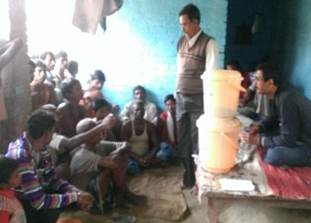|
Affordable Household Water
Purification Solution A rsenic contamination of groundwater and its consequences to human health are a very serious matter. Long term exposure to arsenic via drinking water can cause cancer of the skin, lungs, urinary bladder and kidneys1. Reliable data on the health effects of exposure to arsenic are not easily available but it is clear that there are many countries where arsenic in drinking water has been detected at concentrations greater than the WHO Guidelines Values of 10 ppb2 which pose a risk to public health.Several arsenic removal technologies have been developed and tested. However, most of them have not been able to reach scale due to a number of problems, such as operation and maintenance issues, electricity requirement, lack of awareness of the dangers of arsenic in potable water among the people etc. Some newly emerging technologies, such as nanotechnology, seem to be promising in removing the contaminant from the water. At present much of the research on arsenic removing household filters is still at the laboratory stage (although prototypes are ready) and are yet to find their way into traditional commercial markets. Development Alternatives (DA), through a pilot project in the village of Khagaria (Bihar) planned to establish a ‘lab to land’ connection and develop a business model for a large scale delivery of a suitable appliance in the arsenic affected areas of Bihar. This project was funded by DFID. Selection of appropriate short listed technologies (LayneRT - Ion exchange based resin media, Ion exchange based resin LEWATIT FO36 , Iron based media: Jal-TARA Arsenic and Nanoscale iron oxyhydroxide based media – AMRIT) was followed by preliminary lab validation studies. These technologies were tested and compared across parameters for efficacy in removal of arsenic under conditions of different input water quality, flow rate, conversion of technology to product, affordability of the product, ease of assembly or manufacture etc. Out of these four, the Jal-TARA Arsenic was selected as the most promising. This technology was developed by Technology and Action for Rural Advancement (TARA), a sister organisation of DA. q Sachi Singh 1 http://www.atsdr.cdc.gov/csem/csem.asp?csem=1&po=11 2 Arsenic in Drinking water, WHO Guidelines for
Drinking water, 2011 |
|
In the course of discussion the
Khagaria people clearly said that they
TARA decided to introduce their product the Jal-TARA Arsenic Filter at a subsidised rate of INR 475 for the appliance developed by them even though the production cost of the unit is INR 750. The people were so happy to have a product that works that after discussing the matter among themselves they offered to pay more and fixed the price at INR 525. The demand for TARA’s product is increasing so much that people are making upfront payments to obtain their units at the earliest. |
|
– safe water for all and always Ensuring safe drinking water is amongst the most effective strategies for poverty eradication. Access to safe water and sanitation reduces incidences of water borne fatalities, brings children (especially girls) back to school, empowers women and fosters economic development. In the present time, both quantity and quality of water are highly stressed, especially in the developing world, with serious impacts on the health, life and livelihoods of millions of the poor. Actions are urgently required to address sustainability of water sources and treatment of water to render it fit for drinking. q |
 wanted to get rid of arsenic from
their drinking water and they wanted a speedy and effective solution of
this problem at the earliest. They complained of government and
non-government organisations coming, doing water testings and going back
without providing any solution whatsoever. The people wanted something
practical, effective and affordable.
wanted to get rid of arsenic from
their drinking water and they wanted a speedy and effective solution of
this problem at the earliest. They complained of government and
non-government organisations coming, doing water testings and going back
without providing any solution whatsoever. The people wanted something
practical, effective and affordable.